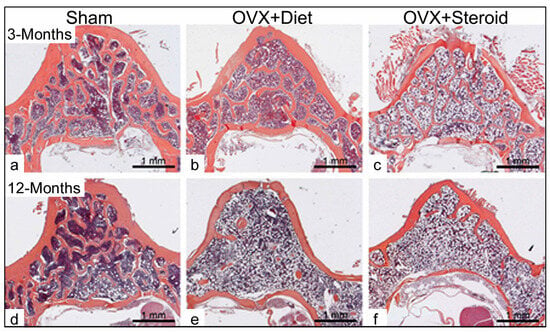Journal Description
Anatomia
Anatomia
is an international, peer-reviewed, open access journal on anatomy published quarterly online by MDPI.
- Open Access free for readers, with article processing charges (APC) paid by authors or their institutions.
- Rapid Publication: manuscripts are peer-reviewed and a first decision is provided to authors approximately 24.9 days after submission; acceptance to publication is undertaken in 2.8 days (median values for papers published in this journal in the second half of 2023).
- Recognition of Reviewers: APC discount vouchers, optional signed peer review, and reviewer names published annually in the journal.
- Anatomia is a companion journal of Life.
Latest Articles
Morphological and Immunohistochemical Characterization of Bone Structure and Cell–Cell Communication in a Rat Osteoporosis Model
Anatomia 2024, 3(2), 93-109; https://doi.org/10.3390/anatomia3020008 - 10 Apr 2024
Abstract
►
Show Figures
Bone remodeling is essential for maintaining bone health. The imbalance between bone formation and bone resorption leads to bone diseases such as osteoporosis. Connexin43 (Cx43) is a gap junction molecule that plays an important role in bone homeostasis. The present study investigates the
[...] Read more.
Bone remodeling is essential for maintaining bone health. The imbalance between bone formation and bone resorption leads to bone diseases such as osteoporosis. Connexin43 (Cx43) is a gap junction molecule that plays an important role in bone homeostasis. The present study investigates the morphological characteristics of bone trabeculae and the distribution of Cx43 in bone cells using osteoporotic rat models to explore the relationship between osteoporosis and bone remodeling. Female Sprague–Dawley rats were divided into three groups: sham, ovarectomy with food deprivation (OVX+diet), and ovarectomy with steroid administration (OVX+steroid) for 3 and 12 months to induce osteoporosis. The lumbar vertebrae were processed for histomorphometric and immunohistochemical evaluation of the trabeculae and the distribution of Cx43 in bone cells. The data showed a significant reduction in trabecular bone in both osteoporotic groups. After 12 months, the OVX+diet treatment resulted in reduced mineralization and an increase in unmineralized bone. The percentage of alkaline phosphatase-positive areas in the OVX+diet vertebrae was lower at 12 months compared to the sham group. A significant increase in tartrate-resistant acid phosphatase (TRAP) positive osteoclasts was observed in the OVX+diet group. Both osteoporotic groups showed a decrease in Cx43-positive osteoblasts areas. An increase in the number of osteoclasts positive for Cx43 was detected in the OVX+diet group. The changes in Cx43 distribution in bone cells, together with trabecular mineralization, suggest that Cx43 may play a role in the progression of osteoporosis and could be a valuable target to improve bone remodeling.
Full article
Open AccessArticle
Cytoarchitectonic Analysis and 3D Maps of the Mesial Piriform Region in the Human Brain
by
Olga Kedo, Sebastian Bludau, Christian Schiffer, Hartmut Mohlberg, Timo Dickscheid and Katrin Amunts
Anatomia 2024, 3(2), 68-92; https://doi.org/10.3390/anatomia3020007 - 07 Apr 2024
Abstract
The mesial piriform region plays a central role in olfaction. Its small size and complex geometry, however, make it a difficult target in functional neuroimaging studies, while histological maps often represent schematic drawings, which are not compatible with requirements for modern imaging. To
[...] Read more.
The mesial piriform region plays a central role in olfaction. Its small size and complex geometry, however, make it a difficult target in functional neuroimaging studies, while histological maps often represent schematic drawings, which are not compatible with requirements for modern imaging. To bridge this gap, cytoarchitectonic analysis and mapping of the region was performed in serial histological sections over their full extent in 10 postmortem brains. The temporobasal areas PirTBd and PirTBv and temporal areas PirTu and PirTit were identified and analyzed. Probabilistic cytoarchitectonic maps of the piriform areas in MNI reference space and high-resolution maps of the amygdala-piriform region on the BigBrain model were calculated as part of the Julich-Brain. Differences in the cytoarchitectonic “texture” of the region were quantified based on the Gray Level Co-Occurrence Matrix. Results showed that allocortical areas were not consistently associated with the rostral Limen insulae, although it was often suggested as a landmark in neuroimaging protocols. PirTu was associated with the uncal tip. PirTit was the largest area, reaching to the temporal pole, with a “temporal” (caudal) and a “temporopolar” (rostral) part having complex neighborhood relationships. The probabilistic maps reflect interindividual variability; they are openly available via the digital EBRAINS platform to serve as an anatomical reference for studies related to olfaction.
Full article
(This article belongs to the Special Issue Recent Progress in Human Hippocampus Histological Studies)
►▼
Show Figures
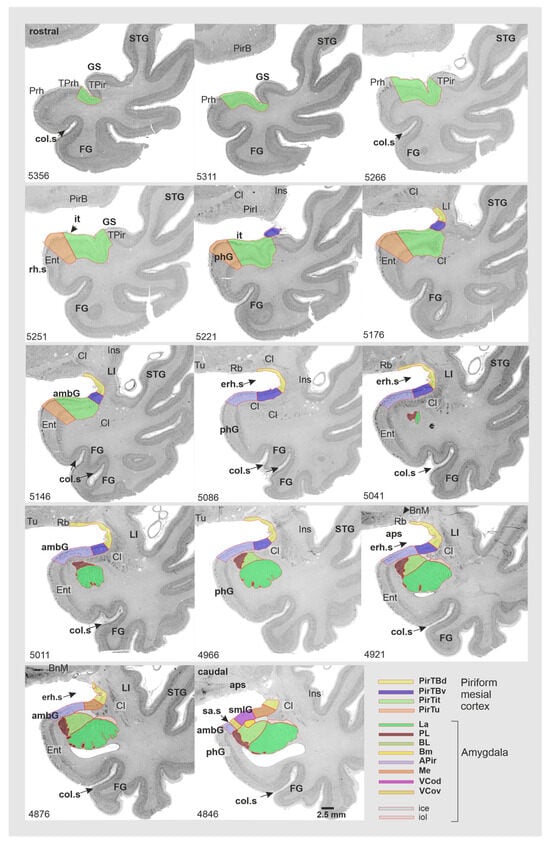
Figure 1
Open AccessCase Report
Detection of the Lassa Virus in a Group of Odontogenic Bone Tumor Tissues
by
Marco de Feo, Frédéric Dilu Tamba, Anguy Makaka Mutondo, Gracia Kashitu Mujinga, Opiyo Stephen Odong, Chiara Castellani, Luca Pavesi, Patrick I. Mpingabo, Steve Ahuka-Mundeke and Silvia Di Agostino
Anatomia 2024, 3(2), 57-67; https://doi.org/10.3390/anatomia3020006 - 26 Mar 2024
Abstract
Odontogenic bone tumor (OT) is a rare pathology in the world, but it is very common in developing countries; its etiology is still unknown, and it causes serious deformities of the mandible and maxilla if it is not operated upon soon. Lassa virus
[...] Read more.
Odontogenic bone tumor (OT) is a rare pathology in the world, but it is very common in developing countries; its etiology is still unknown, and it causes serious deformities of the mandible and maxilla if it is not operated upon soon. Lassa virus (LASV) belongs to the Arenaviridae family, and its reservoir is a rodent of the genus Mastomys. The transmission of the LASV to humans can occur through ingestion or inhalation by contact with dirty objects, the consumption of contaminated food, or exposure to wounds, as rodents shed the virus in their urine and excrement. In this observational study, we aim to evaluate the presence of LASV in OT patient tissues collected in the Democratic Republic of the Congo. For this purpose, a group of nine patients affected by OT were enrolled, and the tissues derived from the surgery were collected. In total, 81.5% of the tissues were positive for LASV presence. Interestingly, we found that not only was the tumor LASV-positive, but in some cases, the bone was close to the tumor and the oral mucosa lining. These preliminary data could suggest the hypothesis that LASV may be involved with the onset of OT.
Full article
(This article belongs to the Topic Human Anatomy and Pathophysiology, 2nd Volume)
►▼
Show Figures
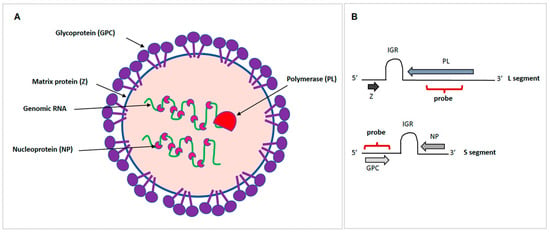
Figure 1
Open AccessEditorial
Advances in Anatomy and Its History
by
Gianfranco Natale and Francesco Fornai
Anatomia 2024, 3(1), 50-56; https://doi.org/10.3390/anatomia3010005 - 14 Mar 2024
Abstract
Anatomy is still considered the most ancient and basic discipline in the medical sciences [...]
Full article
(This article belongs to the Special Issue Advances in Anatomy and Its History)
Open AccessArticle
The Source of Melanocytes in Ortho- and Heterotopic Tail Regenerates of Axolotls and the Dependence of the Regenerative Response on the Presence of Neural Tissue
by
Günter Clemen, Uwe Kierdorf, Michael Hermes and Horst Kierdorf
Anatomia 2024, 3(1), 29-49; https://doi.org/10.3390/anatomia3010004 - 29 Feb 2024
Abstract
►▼
Show Figures
We studied the regeneration of orthotopic and heterotopic tails in larval axolotls. First, we analyzed tail regeneration following reciprocal exchange of cuffs of tail integument between dark-colored (wild-type) and yellow-colored (hybrid) larval animals. Second, we studied tail regeneration in larval axolotls following transplantation
[...] Read more.
We studied the regeneration of orthotopic and heterotopic tails in larval axolotls. First, we analyzed tail regeneration following reciprocal exchange of cuffs of tail integument between dark-colored (wild-type) and yellow-colored (hybrid) larval animals. Second, we studied tail regeneration in larval axolotls following transplantation of cuffs of tail integument from metamorphosed dark-colored conspecifics and from an adult fire salamander. In all cases, the amputation planes involved the transplanted integumental cuffs. In the first experiment, the regenerated tails showed the color of the host animals, not that of the transplanted cuffs. This suggests that the melanocytes of the regenerated tails were derived from the host hypodermis. Following transplantation of metamorphosed skin from axolotls and a fire salamander onto larval axolotls, the metamorphosed epidermis reverted to a larval condition. This indicates that the state of differentiation of the metamorphosed epidermis was not permanent. Rather, in order to maintain the metamorphosed epidermal structure, a continuous exposure of the animals to sufficient levels of thyroid hormones was required. Transplantation of tail buds from yellow-colored onto dark-colored axolotl embryos caused the formation of yellow-colored tails both in the head and the anterior limb region of the hosts. Incomplete resection of these heterotopic tails was followed by tail regeneration, while no tail regeneration occurred following complete resection of the heterotopic tails. Successful tail regeneration depended on the presence of neural tissue along the resection plane.
Full article
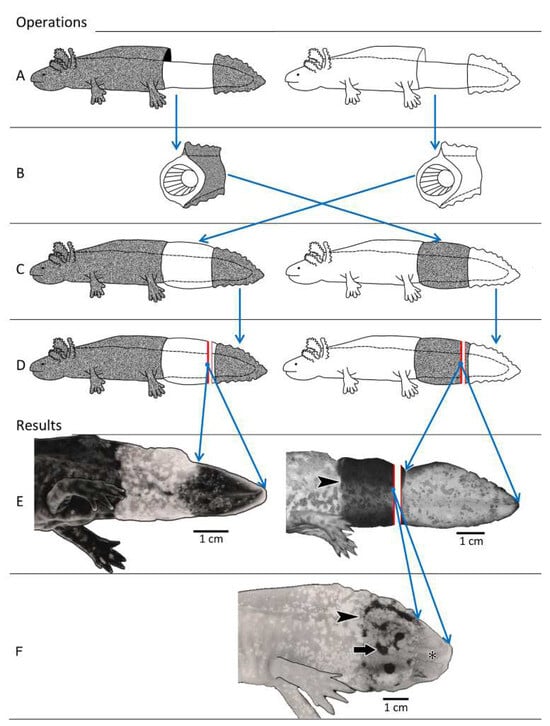
Figure 1
Open AccessArticle
The Impact of Patient-Specific Positions on the Relationship between Iliac Blood Vessels and Lumbar Intervertebral Discs: Anatomical Significance and Clinical Implications
by
Hakija Bečulić, Emir Begagić, Amina Džidić-Krivić, Ragib Pugonja, Belma Jaganjac, Melica Imamović-Bošnjak, Edin Selimović, Amila Čeliković, Rasim Skomorac, Alma Efendić, Fahrudin Alić, Anes Mašović, Selma Terzić-Salihbašić, Lejla Tandir-Lihić and Mirza Pojskić
Anatomia 2024, 3(1), 16-28; https://doi.org/10.3390/anatomia3010003 - 15 Feb 2024
Abstract
This study explores the anatomical relationship between iliac blood vessels and the lower lumbar spine during supine and prone patient positions. The average height of participants was 174.02 cm ± 9.01, while the average weight was 80.38 kg ± 13.48. Body mass index
[...] Read more.
This study explores the anatomical relationship between iliac blood vessels and the lower lumbar spine during supine and prone patient positions. The average height of participants was 174.02 cm ± 9.01, while the average weight was 80.38 kg ± 13.48. Body mass index (BMI) analyses showed differences (p = 0.002), with 34.7% classified as normal weight, 53.1% as overweight, and 12.2% as moderately obese. The study examined the distances between iliac arteries and veins in relation to intervertebral anterior and posterior disc contours. Patient positioning significantly affected these measurements at both L4/L5 and L5/S1 levels. The findings highlight the critical influence of body position on anatomical relationships in the context of lower lumbar spine surgery. The study underscores the importance of preoperative awareness of vascular anatomy to prevent iatrogenic lesions during spine surgery, contributing valuable insights for optimizing surgical approaches and minimizing complications in spine surgery, particularly microdiscectomy.
Full article
(This article belongs to the Topic Human Anatomy and Pathophysiology, 2nd Volume)
►▼
Show Figures
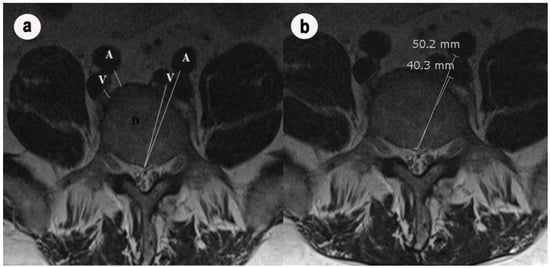
Figure 1
Open AccessCase Report
An Independent C1 Nerve Root Variant of the Ansa Cervicalis: A Case Report
by
Eric Lassiter, Julia M Keating, Kristina Tarter, Kylie Saxton, Sanjana Yerubandi, Safa Habib, Brianna Bailey and Adel Maklad
Anatomia 2024, 3(1), 8-15; https://doi.org/10.3390/anatomia3010002 - 31 Jan 2024
Abstract
►▼
Show Figures
The ansa cervicalis (AC) is a neural loop within the carotid triangle of the anterior neck. The loop is traditionally formed by nerve roots C1–C3 of the cervical plexus and extends multiple motor branches. The current case was discovered during a routine dissection
[...] Read more.
The ansa cervicalis (AC) is a neural loop within the carotid triangle of the anterior neck. The loop is traditionally formed by nerve roots C1–C3 of the cervical plexus and extends multiple motor branches. The current case was discovered during a routine dissection as an anatomical variation of the right AC in an 86-year-old Caucasian male cadaver. In this variation, the C1 nerve root did not form the typical loop with the C2 and C3 nerve roots, but instead, remained independent, traveling deep to the superior belly of the omohyoid muscle to supply the sternothyroid muscle. Because no loop was formed, the anatomy of the current case was not an ansa according to the Latin origin of the word, meaning handle or loop. The AC is an important anatomical landmark within the neck and is implicated in laryngeal reinnervation and respiratory nerve stimulation for patients with sleep apnea. The current anatomical variant contributes to a relatively limited catalog of identified anomalies. Knowledge of new AC variations can guide future surgical interventions and further develop the current base of knowledge surrounding the neuromuscular structures of the head and neck.
Full article
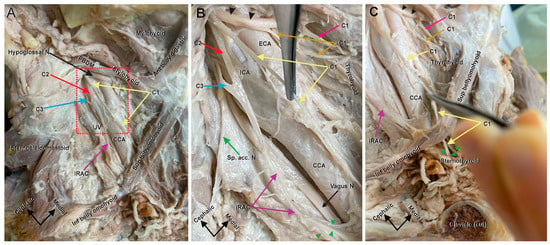
Figure 1
Open AccessCase Report
Conjoined Lumbosacral (L7-S1) Nerve Roots in a Dog
by
Esther Lichtenauer, Koen Santifort, Dorien Willems, Vicente Aige-Gil and Niklas Bergknut
Anatomia 2024, 3(1), 1-7; https://doi.org/10.3390/anatomia3010001 - 03 Jan 2024
Abstract
►▼
Show Figures
Vertebral and spinal cord anomalies are well known in veterinary medicine. However, nerve root anomalies are seldomly reported. In human patients, nerve root anomalies can cause back pain and radicular pain. In human medicine, nerve root anomalies are more often found in cadaveric
[...] Read more.
Vertebral and spinal cord anomalies are well known in veterinary medicine. However, nerve root anomalies are seldomly reported. In human patients, nerve root anomalies can cause back pain and radicular pain. In human medicine, nerve root anomalies are more often found in cadaveric studies than in imaging studies, representing the lack of advanced imaging in the past and the unawareness about these pathologies. Additionally, nerve root anomalies can mimic other pathologies in imaging studies. It is important to know about the anatomy of the individual patient not only for correctly localizing the pathology but also for surgical planning and to prevent iatrogenic trauma to the patient. Conjoined nerve roots are a type of nerve root anomaly described in human medicine and are defined as two nerve roots that either share a common dural envelope at some point during their course from the dural sac or that have their origin very close together in the dural sac. In humans, lumbosacral nerve roots are most commonly conjoined, and signs of pain may be associated with this anomaly. We report the magnetic resonance imaging finding of right-sided conjoined L7 and S1 nerve roots in a dog that presented with lumbosacral hyperesthesia. We postulate that it is possible that the conjoined nerve roots played a role in the clinical signs of this dog. This is an anomaly that has not been reported before in veterinary medicine.
Full article

Figure 1
Open AccessReview
Juan Valverde de Amusco: Pioneering the Transfer of Post-Vesalian Anatomy
by
Luis-Alfonso Arráez-Aybar, Concepción Reblet and José Luis Bueno-López
Anatomia 2023, 2(4), 450-471; https://doi.org/10.3390/anatomia2040033 - 11 Dec 2023
Abstract
This article delves into the life and accomplishments of Juan Valverde de Amusco (c. 1525–c. 1587), a Spanish anatomist. Specifically, it focuses on his book titled HISTORIA de la composición del cuerpo humano. The book was the first anatomy opus published after
[...] Read more.
This article delves into the life and accomplishments of Juan Valverde de Amusco (c. 1525–c. 1587), a Spanish anatomist. Specifically, it focuses on his book titled HISTORIA de la composición del cuerpo humano. The book was the first anatomy opus published after Andreas Vesalius’ De humani corporis fabrica libri septem, written in a Romance language, the Castilian Spanish language, making it the most renowned post-Vesalian anatomy book in Europe and beyond during the 16th and 17th centuries. Compiling complete editions and reproductions of figures, it had 19 editions and several translations. One of its principal contributions was the initial graphical representation of the stapes ossicle. It provided the first accurate description of the pulmonary circulation, vomer bone, and four extraocular rectus muscles. Throughout the book, Valverde corrected numerous of Vesalius’ anatomical observations. HISTORIA de la composición del cuerpo humano was the first anatomy book to use chalcographic illustrations, which are of superior anatomical quality than those printed from engraved wood in Andreas Vesalius’ book. Next, many anatomy textbooks of that time incorporated Valverde’s book illustrations. Valverde’s book was practical, timely, and well referenced, making it a valuable resource for scholars and non-scholars. The conclusion is that Juan Valverde de Amusco merits a place as a pioneer in scientific knowledge transfer.
Full article
(This article belongs to the Special Issue Advances in Anatomy and Its History)
►▼
Show Figures

Figure 1
Open AccessArticle
On the Blueprint of the Long Primary Afferent Axons and the Dichotomous Axon Trajectory of Clarke’s Nucleus. A Morphological Tracing Study on the Effect of Hypoxia during Development
by
Frits C. de Beer and Harry W. Steinbusch
Anatomia 2023, 2(4), 414-449; https://doi.org/10.3390/anatomia2040032 - 06 Dec 2023
Abstract
►▼
Show Figures
The primary afferent system in the rat’s spinal cord starts to develop in the third last week of gestation. First, the pseudounipolar DRG neurons extend their centripetal long primary axons, targeting rostral supra-segmental nuclei in the spinal cord. Meanwhile, the subsequent innervation of
[...] Read more.
The primary afferent system in the rat’s spinal cord starts to develop in the third last week of gestation. First, the pseudounipolar DRG neurons extend their centripetal long primary axons, targeting rostral supra-segmental nuclei in the spinal cord. Meanwhile, the subsequent innervation of the juxta- and intra-segmental spinal levels enables the three subdivisions to commence integrating a complex network with the body periphery. This process may continue to refine and adapt the system life-long. The experimental data elucidated the steps involved in developing the cytoarchitecture by separating the axons of the long and intermediate subdivisions from the short subdivision. Here, we present a blueprint of the features of the long primary afferent axons developing in sequential waves. The pioneering long afferent axons targeted the dorsal gracile nuclei at spring tide and Clarke’s nuclei at neap tide in ventrally bent trajectories. The paradigm’s myelotomy blocked these pioneering fibers from stepping down the developmental cascade, rendering an unknown phenotype. This reflected a hypothetical transition hub stationed on the assembly line, delineating a critical period. The paradigm also affected the neuropil’s ripening independently from the long primary afferent system. The data disclosed that fetal hyposaturation yielded an in vivo genomic engineering capability. Fetal tissue was susceptible to hyposaturation, showing remarkable versatility early in fetal life. The translational impact may favor research into the elusive etiology of clinical syndromes concerning the afferent system relating to fetal hyposaturation.
Full article

Figure 1
Open AccessReview
Pheromone Sensing in Mammals: A Review of the Vomeronasal System
by
Mateo V. Torres, Irene Ortiz-Leal and Pablo Sanchez-Quinteiro
Anatomia 2023, 2(4), 346-413; https://doi.org/10.3390/anatomia2040031 - 09 Nov 2023
Cited by 2
Abstract
This review addresses the role of chemical communication in mammals, giving special attention to the vomeronasal system in pheromone-mediated interactions. The vomeronasal system influences many social and sexual behaviors, from reproduction to species recognition. Interestingly, this system shows greater evolutionary variability compared to
[...] Read more.
This review addresses the role of chemical communication in mammals, giving special attention to the vomeronasal system in pheromone-mediated interactions. The vomeronasal system influences many social and sexual behaviors, from reproduction to species recognition. Interestingly, this system shows greater evolutionary variability compared to the olfactory system, emphasizing its complex nature and the need for thorough research. The discussion starts with foundational concepts of chemocommunication, progressing to a detailed exploration of olfactory systems. The neuroanatomy of the vomeronasal system stands in contrast with that of the olfactory system. Further, the sensory part of the vomeronasal system, known as the vomeronasal organ, and the integration center of this information, called the accessory olfactory bulb, receive comprehensive coverage. Secondary projections of both the olfactory and vomeronasal systems receive attention, especially in relation to the dual olfactory hypothesis. The review concludes by examining the organization of the vomeronasal system in four distinct mammalian groups: rodents, marsupials, herpestids, and bovids. The aim is to highlight the unique morphofunctional differences resulting from the adaptive changes each group experienced.
Full article
(This article belongs to the Special Issue Advances in Anatomy and Its History)
►▼
Show Figures

Figure 1
Open AccessBrief Report
Renal Lobulation—A Benign Macroanatomical Variation?
by
Serghei Covantsev, Oleg Arnaut, Karina Mulaeva and Olga Belic
Anatomia 2023, 2(4), 336-345; https://doi.org/10.3390/anatomia2040030 - 08 Nov 2023
Abstract
►▼
Show Figures
Introduction: Renal lobulation (also known as fetal or embryonic lobulation) is a rare variation during development in which renal lobules have a visible anatomical space between them, and this can be seen in 0.5–4% of adults. Material and methods: this study was conducted
[...] Read more.
Introduction: Renal lobulation (also known as fetal or embryonic lobulation) is a rare variation during development in which renal lobules have a visible anatomical space between them, and this can be seen in 0.5–4% of adults. Material and methods: this study was conducted on 54 human kidneys from patients who died due to causes unrelated to renal pathology which were fixed in a 10% formaldehyde solution and then carefully dissected. Results: The group with fetal lobulation (n = 16) was associated with a length M = 9.89 (SD = 0.6, p = 0.15). By comparison, the kidneys without lobulation (n = 38) were associated with a numerically longer length M = 10.29 (SD = 0.607, p = 0.098). To test the hypothesis that lobulation is associated with a statistically significant different length a Mann–Whitney test was performed, which indicated that the length of the kidneys is smaller in scase of lobulation U = 198, Z = −2.04, p = 0.04. Cross-tabulation also demonstrated that kidney lobulation may be influenced by the presence of polar arteries with r = 0.41 (p < 0.02). The likelihood ratio was 7.28, df 1, p = 0.003, with an odds ratio of 6.857 (CI 95% = 1.84–25.61). Logistic regression analysis demonstrated that kidneys with lobulation were 6.85 times more likely to have polar arteries than kidneys without lobulation. Conclusions: the data from our research indicate that even though no pathological conditions have been linked with lobulated kidneys, the incidence of vascular variations (specifically polar arteries) is higher when there is persistent fetal lobulation.
Full article
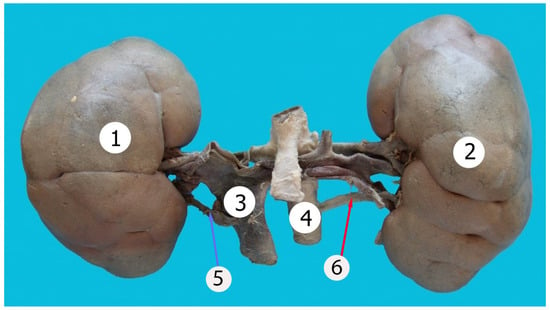
Figure 1
Open AccessCommunication
Hippocampal Asymmetry Increases with Age
by
Florian Kurth and Eileen Luders
Anatomia 2023, 2(4), 328-335; https://doi.org/10.3390/anatomia2040029 - 16 Oct 2023
Abstract
It is unclear whether differences between the two brain hemispheres become larger or smaller with increasing age. Given that the hippocampus is particularly susceptible to age-related changes, here, we set out to investigate the correlation between chronological age and hippocampal asymmetry, both for
[...] Read more.
It is unclear whether differences between the two brain hemispheres become larger or smaller with increasing age. Given that the hippocampus is particularly susceptible to age-related changes, here, we set out to investigate the correlation between chronological age and hippocampal asymmetry, both for the hippocampal complex as a whole and in cytoarchitectonically defined subregions (cornu ammonis 1, 2, 3, dentate gyrus, subiculum, and entorhinal cortex). We analyzed T1-weighted data of the brain from a sample of 725 healthy individuals (406 women/319 men) spanning a wide age range (36–100 years) from The Lifespan Human Connectome Project in Aging. Correlations between the absolute asymmetry index and chronological age were positive for all six subregions and also for the hippocampal complex as a whole, albeit effects the effects were not significant for the dentate gyrus. This suggests that, overall, hippocampal asymmetry increases with increasing age (i.e., the left and right hippocampi become more different over time). Given that the subregions of the hippocampal complex serve different brain functions, follow-up research is needed to explore the functional implications within the framework of brain aging. In addition, longitudinal studies will be necessary to confirm the observed cross-sectional effects.
Full article
(This article belongs to the Special Issue Neuroanatomy, Neuroinflammation and Neurodegeneration)
►▼
Show Figures
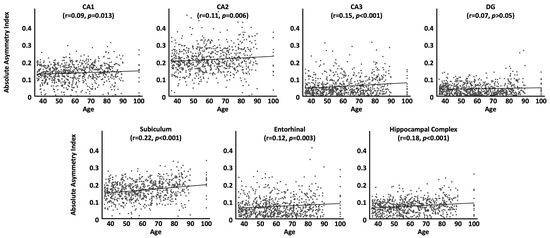
Figure 1
Open AccessCase Report
A Rare Bilateral Variation in the Branches of the Internal Thoracic Artery: A Case Report
by
Jihad S. Hawi, Rosalyn A. Jurjus, Hisham S. Daouk, Maya N. Ghazi, Charbel A. Basset, Francesco Cappello, Inaya Hajj Hussein, Angelo Leone and Abdo R. Jurjus
Anatomia 2023, 2(4), 320-327; https://doi.org/10.3390/anatomia2040028 - 12 Oct 2023
Abstract
Background: Anatomical variations and, in particular, arterial variations constitute an important chapter in the learning of Clinical Anatomy. Purpose: The purpose of this report is to describe a rare bilateral anatomical variation in the internal thoracic artery (ITA) in a 60-year-old corpse and
[...] Read more.
Background: Anatomical variations and, in particular, arterial variations constitute an important chapter in the learning of Clinical Anatomy. Purpose: The purpose of this report is to describe a rare bilateral anatomical variation in the internal thoracic artery (ITA) in a 60-year-old corpse and to depict its extreme clinical importance in coronary artery bypass surgery. Methods: The rare bilateral aberrant branches of the internal thoracic artery and their course in the thorax were incidentally discovered during routine anatomy dissection of the thorax at the Faculty of Medicine and Medical Sciences of the University of Balamand. The findings were thoroughly documented using digital photography, and the dissection followed the instructions from the “16th Edition of Grant’s Dissector”. Results: In the observed case, the left aberrant branch of ITA descends laterally and gives medial and lateral anterior intercostal branches at the first six intercostal spaces. Conversely, the right aberrant artery, which branches from the ITA, descends laterally and gives medial and lateral branches to every intercostal space in the first five intercostal spaces. Conclusion: This report emphasizes that any unexpected variations in the lateral aberrant branches of the internal thoracic artery may complicate the surgical procedure. Bilateral aberrant lateral branches of the internal thoracic artery constitute rare anatomical variations of the internal thoracic artery and have been rarely reported in the literature. Such a course for aberrant lateral branches in the thorax poses possible lethal complications during several procedures involving the thorax, including basic coronary artery bypass graft, thoracocentesis and intercostal paracentesis and breast reconstruction.
Full article
(This article belongs to the Special Issue Advances in Anatomy and Its History)
►▼
Show Figures

Figure 1
Open AccessReview
Molecular Anatomy of Prostate Cancer and Its Implications in Active Surveillance and Early Intervention Strategies
by
Sandy Figiel, Géraldine Cancel-Tassin, Ian G. Mills, Alastair D. Lamb, Gaelle Fromont and Olivier Cussenot
Anatomia 2023, 2(4), 300-319; https://doi.org/10.3390/anatomia2040027 - 10 Oct 2023
Abstract
Understanding prostate carcinogenesis is crucial not only for identifying new treatment targets but also for developing effective strategies to manage the asymptomatic form of the disease. There is a lack of consensus about predicting the indolent form of the disease prostate cancer, leading
[...] Read more.
Understanding prostate carcinogenesis is crucial not only for identifying new treatment targets but also for developing effective strategies to manage the asymptomatic form of the disease. There is a lack of consensus about predicting the indolent form of the disease prostate cancer, leading to uncertainties regarding treatment initiation. This review aims to enhance the assessment and management of early prostate cancer by providing a comprehensive picture of the molecular anatomy of the prostate, synthesising current evidence, highlighting knowledge gaps, and identifying future directions. It presents evidence for the efficacy of active surveillance as an alternative treatment strategy and its potential benefits in specific patient groups through androgen receptor disruption. Overall, an improved understanding of prostate carcinogenesis and its molecular underpinnings can pave the way for tailored and precise management approaches for this common cancer. Further development and validation of molecule-based assessment tools are needed. Integrating genomic, proteomic, and phenotypic models, as well as functional approaches, can help predict outcomes. This facilitates selecting candidates for active surveillance and targeting interventions for higher-risk cases, contributing to more precise management strategies.
Full article
(This article belongs to the Special Issue Anatomy for Modern Urology)
►▼
Show Figures
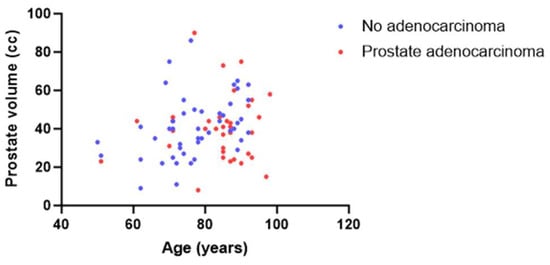
Figure 1
Open AccessReview
Radiological Diagnosis and Imaging of Femoral Shaft Fractures
by
Kathleen H. Miao and Julia H. Miao
Anatomia 2023, 2(3), 282-299; https://doi.org/10.3390/anatomia2030026 - 07 Sep 2023
Cited by 2
Abstract
►▼
Show Figures
Femoral shaft fractures (FSFs) are common orthopedic injuries, often resulting from high-energy trauma such as motor vehicle collisions, low-energy trauma, osteoporosis, or pathological conditions. They account for a significant portion of long bone fractures. Radiologic imaging plays a pivotal role in the diagnosis
[...] Read more.
Femoral shaft fractures (FSFs) are common orthopedic injuries, often resulting from high-energy trauma such as motor vehicle collisions, low-energy trauma, osteoporosis, or pathological conditions. They account for a significant portion of long bone fractures. Radiologic imaging plays a pivotal role in the diagnosis of these fractures, providing crucial information about fracture characteristics, associated injuries, and successful treatment and management planning. This paper provides a comprehensive review of the anatomy, pathophysiology, and classification systems of FSFs. Diagnostic imaging modalities, including radiograph, computed tomography (CT), and magnetic resonance imaging (MRI), and their essential roles are highlighted, driving treatment and management as well as prognosis for FSFs and illuminating the anatomical considerations that influence the choice of approach and fixation techniques. Radiological diagnosis and imaging of FSFs are vital for orthopedic surgeons, radiologists, and healthcare professionals involved in the care of patients with these injuries and optimizing patient outcomes.
Full article
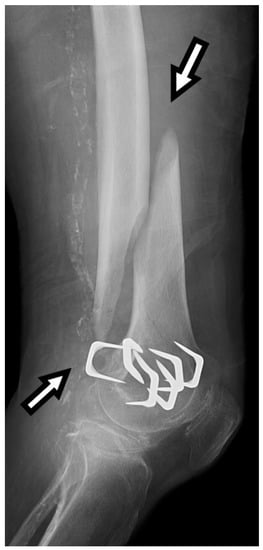
Figure 1
Open AccessCommunication
Metacognition through an Iterative Anatomy AI Chatbot: An Innovative Playing Field for Educating the Future Generation of Medical Students
by
Varna Taranikanti and Cameron J. Davidson
Anatomia 2023, 2(3), 271-281; https://doi.org/10.3390/anatomia2030025 - 06 Sep 2023
Abstract
►▼
Show Figures
Medical educators face many challenges instructing future medical students, specifically in the integration of learning technologies. To overcome these challenges, educators must implement learner-centered and interactive teaching strategies. Anatomical sciences are the cornerstone of medical education and provide the bedrock to layer conceptual
[...] Read more.
Medical educators face many challenges instructing future medical students, specifically in the integration of learning technologies. To overcome these challenges, educators must implement learner-centered and interactive teaching strategies. Anatomical sciences are the cornerstone of medical education and provide the bedrock to layer conceptual understanding of the human body. With the “medical knowledge boom”, most medical schools have reduced the curricular time for anatomy instruction, resulting in a paucity of knowledge and issues incorporating anatomical knowledge in clinical scenarios. Modern pedagogical techniques combining AI chatbots with concurrent metacognitive frameworks can foster a deeper understanding of anatomical knowledge and analysis of clinical cases. Student reflection on the learning process allows for monitoring their progress and tailoring of learning strategies to their specific capabilities and needs. A.I. technology can aid in scaffolding knowledge with practical applications via iterative and immediate feedback in case- or problem-based learning formats. The use of textual conversations actively engages students and simulates conversations with instructors. In this communication, we advocate for the incorporation of AI technologies fused with a metacognitive framework as a medium to foster increased critical thinking and skill development that enhances comprehension. These skills are important for medical students’ lifelong learning process.
Full article
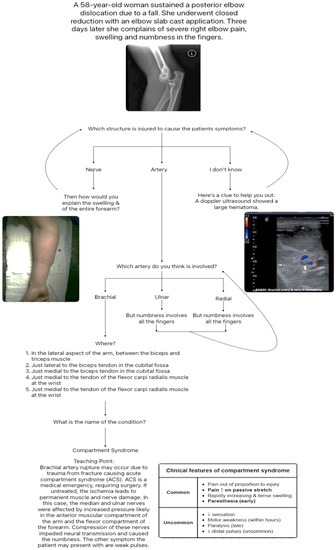
Figure 1
Open AccessReview
Anatomist and Co-Founder of Polish Veterinary Education—Ludwik Henryk Bojanus (1776–1827)
by
Jarosław Sobolewski and Maciej Zdun
Anatomia 2023, 2(3), 261-270; https://doi.org/10.3390/anatomia2030024 - 04 Sep 2023
Abstract
Ludwig Henry Bojanus was born on 16 July 1776 in Buchsweiler, Alsace. After studying in Jena and Vienna, L. H. Bojanus enrolled at the University of Jena for his doctoral studies. Bojanus’s scientific activities are closely associated with Vilnius, where he was a
[...] Read more.
Ludwig Henry Bojanus was born on 16 July 1776 in Buchsweiler, Alsace. After studying in Jena and Vienna, L. H. Bojanus enrolled at the University of Jena for his doctoral studies. Bojanus’s scientific activities are closely associated with Vilnius, where he was a professor of veterinary medicine from 1806 (he was elected to this position in 1804). In 1815, he became a professor of comparative anatomy. These were the times of the greatest flourishing of Vilnius University, where the foundations of modern Polish science were being laid. At Vilnius University, he established a technical and anatomical-pathological office for the zoo, a veterinary clinic and a model forge for shoeing horses in 1823. Bojanus founded a veterinary school in Vilnius and drew up a plan for a veterinary institute, which was not opened until 1832, simultaneously with the opening of the medico-surgical academy. He became known as one of Europe’s most prominent anatomists and zoologists. A lasting memorial to the scientist is the monograph “Anatomy of the Tortoise”, which many scholars still point to today as a model of accurate and precise anatomical research. He was the first to identify the anatomical differences between the European bison (Bos bonasus) and the aurochs (Bos primigenius). In his lectures on comparative anatomy, Bojanus presented the principle of uninterrupted development. He can be described as one of the most decisive and consistent evolutionists before Darwin. He died in 1827.
Full article
(This article belongs to the Special Issue Advances in Anatomy and Its History)
►▼
Show Figures

Figure 1
Open AccessOpinion
The Prostate Is Not a Pill and Therefore Has No Capsule
by
Johannes Kläger, Gabriel Wasinger, André Oszwald and Eva Compérat
Anatomia 2023, 2(3), 253-260; https://doi.org/10.3390/anatomia2030023 - 14 Aug 2023
Abstract
Tumor staging of prostate cancer is a fundamental principle in management and therapy, with a hallmark being tumor growth beyond the organ boundary. Often, this is referred to as “capsule penetration”, suggesting the existence of a true prostatic capsule that would facilitate the
[...] Read more.
Tumor staging of prostate cancer is a fundamental principle in management and therapy, with a hallmark being tumor growth beyond the organ boundary. Often, this is referred to as “capsule penetration”, suggesting the existence of a true prostatic capsule that would facilitate the determination of tumor penetration. In fact, the prostate does not have a true capsule and, depending on the anatomic area, it blends with the surrounding fibrous, adipose and muscular tissue. This makes it sometimes difficult or impossible to unequivocally identify extraprostatic tumor extension. It is necessary to appreciate this difficulty in order to better understand the significance of extraprostatic tumor extension.
Full article
(This article belongs to the Special Issue Anatomy for Modern Urology)
►▼
Show Figures
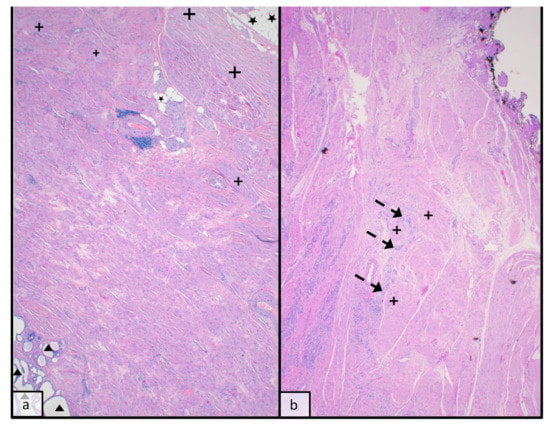
Figure 1
Open AccessCase Report
Brain Abscess Secondary to an Apparently Benign Transorbital Injury: An Infrequent Case Report with Literature Review
by
Hakija Bečulić, Emir Begagić, Rasim Skomorac, Aldin Jusić, Edin Selimović, Lejla Čejvan and Mirza Pojskić
Anatomia 2023, 2(3), 243-252; https://doi.org/10.3390/anatomia2030022 - 09 Aug 2023
Cited by 3
Abstract
Intraorbital and transorbital injuries are included in the group of head injuries with low frequency. In particular, such injuries rarely result in infectious processes in the brain parenchyma. This case presents a case where a 57-year-old man reported to the neurosurgery department that
[...] Read more.
Intraorbital and transorbital injuries are included in the group of head injuries with low frequency. In particular, such injuries rarely result in infectious processes in the brain parenchyma. This case presents a case where a 57-year-old man reported to the neurosurgery department that he had sustained an injury to the conjunctiva of the upper eyelid a month earlier. The patient was injured by a tree branch, which he removed on his own initiative. After persistent eye abduction palsy, an MRI was performed, which showed a compressive mass in the frontal lobe of the brain. A surgical procedure was indicated, which found a piece of twig 3 mm long inside the abscess. Surgical intervention and antibiotic therapy led to the complete recovery of the patient.
Full article
(This article belongs to the Special Issue Neuroanatomy, Neuroinflammation and Neurodegeneration)
►▼
Show Figures
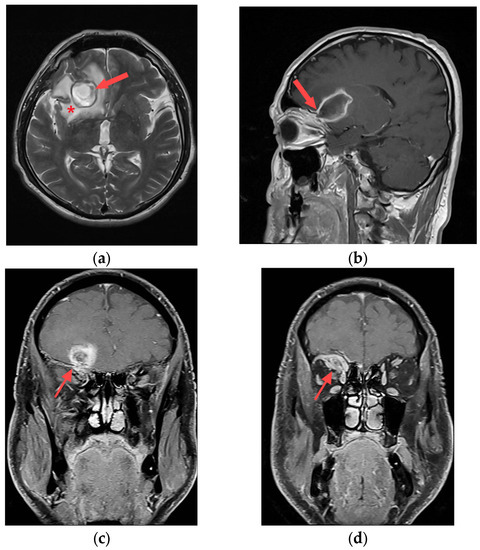
Figure 1
Highly Accessed Articles
Latest Books
E-Mail Alert
News
Topics
Topic in
Anatomia, Biology, Medicina, Pathophysiology, Tomography
Human Anatomy and Pathophysiology, 2nd Volume
Topic Editors: Francesco Cappello, Mugurel Constantin RusuDeadline: 31 May 2024

Conferences
Special Issues
Special Issue in
Anatomia
Neuroanatomy, Neuroinflammation and Neurodegeneration
Guest Editor: Lars Ove BrandenburgDeadline: 31 May 2024
Special Issue in
Anatomia
Anatomy for Modern Urology
Guest Editor: Olivier CussenotDeadline: 30 June 2024
Special Issue in
Anatomia
From Anatomy to Clinical Neurosciences
Guest Editor: Adel MakladDeadline: 31 January 2025

